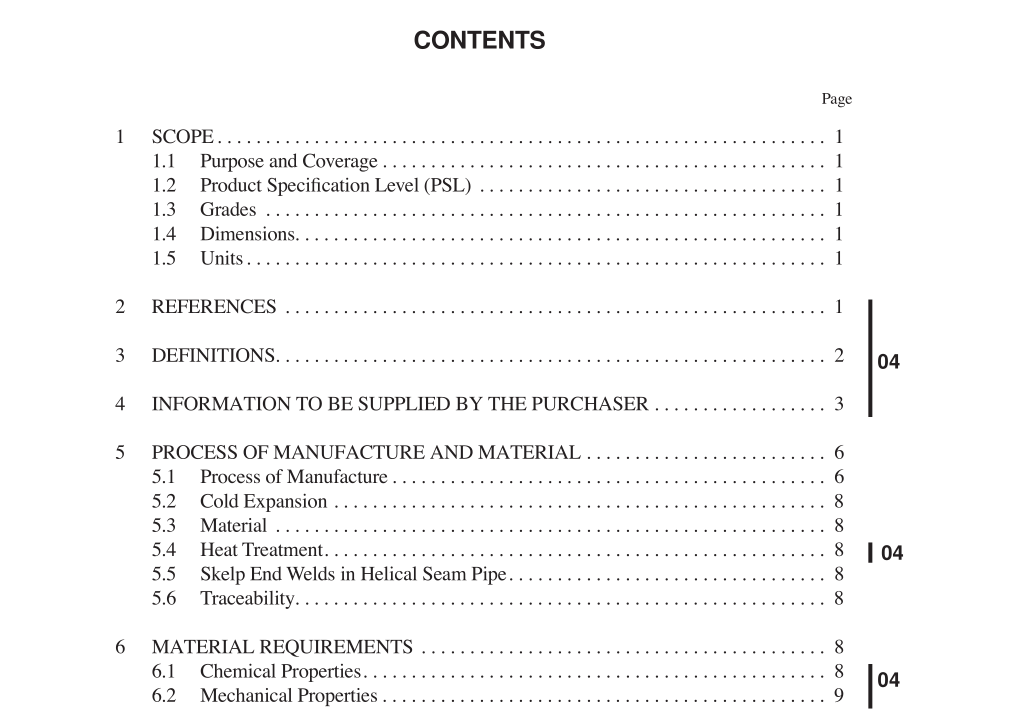API 5L pdf download

API 5L pdf download.Specification for Line Pipe
1 Scope
1.1 PURPOSE AND COVERAGE
The purpose of this speciÞcation is to provide standards for pipe suitable for use in conveying gas, water, and oil in both the oil and natural gas industries. This speciÞcation covers seamless and welded steel line pipe. It includes plain-end, threaded-end, and belled-end pipe, as well as through-the-ßowline (TFL) pipe and pipe with ends prepared for use with special couplings. Although the plain-end line pipe meeting this speciÞcation is primarily intended for Þeld makeup by circumferential welding, the manufacturer will not assume responsibility for Þeld welding.
1.2 PRODUCT SPECIFICATION LEVEL (PSL)
This speciÞcation establishes requirements for two product speciÞcation levels (PSL 1 and PSL 2). These two PSL desig- nations deÞne different levels of standard technical require- ments. PSL 2 has mandatory requirements for carbon equivalent, notch toughness, maximum yield strength, and maximum tensile strength. These and other differences are summarized in Appendix J. Requirements that apply to only PSL 1 or only PSL 2 are so designated. Requirements that are not designated to a spe- ciÞc PSL apply to both PSL 1 and PSL 2. The purchaser may add requirements to purchase orders for either PSL 1 or PSL 2, as provided by the supplementary requirements (Appendix F) and other options (4.2 and 4.3).
1.3 GRADES
The grades (see the note) covered by this speciÞcation are the standard Grades A25, A, B, X42, X46, X52, X56, X60, X65, X70 and X80; and any intermediate grades (grades that are higher than X42, intermediate to two sequential standard grades, and agreed upon by the purchaser and manufacturer). PSL 1 pipe can be supplied in Grades A25 through X70. PSL 2 pipe can be supplied in Grades B through X80. Class II (Cl II) steel is rephosphorized and probably has better threading properties than Class I (Cl I). Because Class II (Cl II) has higher phosphorus content than Class I (Cl I), it may be somewhat more difÞcult to bend. Pipe manufactured as Grade X60 or higher shall not be substituted for pipe ordered as Grade X52 or lower without purchaser approval. Note: The grade designations are dimensionless. Grades A and B do not include reference to the speciÞed minimum yield strength; how- ever, other grade designations are composed of the letter A or X, fol- lowed by the Þrst two digits of the speciÞed minimum yield strength in U.S. Customary units.
1.4 DIMENSIONS
The sizes used herein are dimensionless designations, which are derived from the speciÞed outside diameter as mea- sured in U.S. Customary units, and provide a convenient method of referencing pipe size within the text and tables (but not for order descriptions). Pipe sizes 23/8 and larger are expressed as integers and fractions; pipe sizes smaller than 23/8 are expressed to three decimal places. These sizes replace the “size designation” and the “nominal size designa- tion” used in the previous edition of this speciÞcation. Users of this speciÞcation who are accustomed to specifying nomi- nal sizes rather than OD sizes are advised to familiarize them- selves with these new size designations used in this speciÞcation, especially the usage in Tables 4, 5, and 6A. PSL 1 pipe can be supplied in sizes ranging from 0.405 through 80. PSL 2 pipe can be supplied in sizes ranging from 4 1 / 2 through 80. Dimensional requirements on threads and thread gages, stipulations on gaging practice, gage speciÞcations and certi- Þcation, as well as instruments and methods for inspection of threads are given in API Standard 5B and are applicable to threaded products covered by this speciÞcation.









